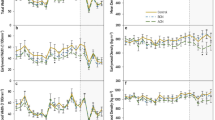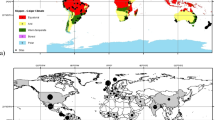Summary
Studies of plant standing crop and nutrient concentrations have enabled an assessment of the seasonal changes in nutrient standing stocks (the mass of nutrients per m2) in a fjaeldmark and two fernbrake communities on Marion Island (46°54′S, 37°45′E). These communities are an important component of the island's vegetation on rocky plateaux and slopes. For most species the aboveground accumulations of N, P and K early in the season were more rapid than increases in the aerial biomass. Rates of Ca, Mg or Na accrual were either similar to, or lower than, rates of aboveground growth. Nutrient (N+P+K+Ca+Mg+Na) standing stocks at the three communities were high; 71 g m-2 at fjaeldmark, 116 g m-2 at open fernbrake and 154 g m-2 at closed fernbrake. The aboveground component accounted for 47% to 65% of these values. N was the most abundant element in the vegetation, followed by K (closed fernbrake) or Ca (open fernbrake and fjaeldmark). Nutrient standing stocks at the two fernbrakes were mostly higher than for most sub-Arctic and alpine dwarf-shrub tundras. Nutrient pool sizes (i.e. the total quantities of nutrients contained in the soil/plant system to a depth of 25 cm) were lower than those reported for arctic tundra meadows but were similar to, and often greater than, those found at heath communities, sub-Arctic dry meadows and dwarf-shrub tundras and some boreal forests. Annual net primary productions of the fernbrake vegetations were high and substantial quantities of nutrients are aquired annually from the soils by the vegetations. Depending on plant species, either N or K was the element taken up in the largest quantity, whereas P was mostly taken up in the lowest amount. A large proportion (mostly all) of the Ca and Mg and a substantial proportion of the N taken up aboveground was lost in the litterfall but little of K taken up was lost in this way.
Similar content being viewed by others
References
Chapin FS III, Van Cleve K, Tieszen LL (1975) Seasonal dynamics of tundra vegetation at Barrow, Alaska. Arct Alp Res 7:209–226
Chapin FS III, Miller PC, Billings WD, Coyne PI (1980) Carbon and nutrient budgets and their control in coastal tundra. In: Brown J, Miller PC, Tieszen LL, Bunnel FL (eds) An Arctic ecosystem. US/IBP Synthesis Ser 12. Dowden Hutchinson and Ross, Pennsylvania, pp 458–482
Chapman SB (1970) The nutrient content of the soil and root system of a dry heath ecosystem. J Ecol 58:445–452
Chepurko NL (1972) The biological productivity and the cycle of nitrogen and ash elements in the dwarf shrub tundra ecosystem of the Khibini Mountains (Kola Peninsula). In: Weilgolaski FE, Rosswall T (eds) Tundra biome. Proc 4th Int Meeting on the Biological Productivity of Tundra, Leningrad USSR, October 1971. Tundra Biome Steering Committee, Stockholm (Sweden), pp 236–247
Dowding P, Chapin FS III, Wielgolaski FE, Kilfeather P (1981) Nutrients in tundra ecosystems. In: Bliss LC, Heal OW, Moore JJ (eds) Tundra ecosystems: a comparative analysis. International Biological Programme 25. Cambridge University Press, Cambridge, pp 647–683
French DD, Smith VR (1985) A comparison between northern and southern hemisphere tundras and related habitats. Polar Biol 5:5–21
Gremmen NJM (1981) The vegetation of the Subantarctic islands Marion and Prince Edward. Geobotany, vol 3. W Junk, The Hague, 149 pp
Klopatek JM (1978) Nutrient dynamics of freshwater riverine marshes and the role of emergent macrophytes. In: Good RE, Whigham DF, Simpson RL (eds) Freshwater wetlands. Ecological processes and management potential. Academic Press, New York, pp 195–216
Mackereth FJH, Heron J, Talling JF (1978) Water analysis: some methods for the limnologist. Freshwater Biol Ass Sc Publ 36. Wilson & Son, Kendal (England)
Martin NJ, Holding AJ (1978) Nutrient availability and other factors limiting microbial activity in the blanket peat. In: Heal OW, Perkins DF (eds) Production ecology of British moors and montane grasslands. Ecological studies, vol 27. Springer, Berlin Heidelberg New York, pp 113–135
Murphy J, Riley JP (1962) A modified single solution method for the determination of phosphate in natural waters. Anal Chim Acta 27:31–36
Perkins DF, Jones V, Millar RO, Neep P (1978) Primary production, mineral nutrients and litter decomposition in the grassland ecosystem. In: Heal OW, Perkins DF (eds) Production ecology of British moors and montage grasslands. Ecological studies, vol 27. Springer, Berlin Heidelberg New York, pp 304–331
Rehder H (1976) Nutrient turnover studies in alpine ecosystems. II. Phytomass and nutrient relations in the Caricetum firmae. Oecologia (Berlin) 23:49–62
Rehder H, Schäfer A (1978) Nutrient turnover studies in alpine ecosystems. IV. Communities of the Central Alps and comparative survey. Oecologia (Berlin) 34:309–327
Robertson RA, Davies GE (1965) Quantities of plant nutrients in heather ecosystems. J Appl Ecol 2:211–219
Rosswall T, Granhall U (1980) Nitrogen cycling in a subarctic ombrotrophic mire. In: Sonesson M (ed) Ecology of a Subarctic mire. Ecol Bull (Stockholm) 30:209–234
Smith VR (1976) Standing crop and nutrient status of Marion Island (sub-Antarctic) vegetation. J S Afr Bot 42:231–263
Smith VR (1977) Vegetation standing crop of the grey lava flows and of the eastern coastal plain on Marion Island. J S Afr Bot 43:105–114
Smith VR (1987a) Production and nutrient dynamics of plant communities on a sub-Antarctic island. 2. Standing crop and primary production of fjaeldmark and fernbrakes. Polar Biol 7:125–144
Smith VR (1987b) Seasonal changes in plant and soil chemical composition at Marion Island (sub-Antarctic). II. Fjaeldmark and fernbrakes. S Afr J Antarct Res 17 (in press)
Smith VR (1987c) Production and nutrient dynamics of plant communities on a sub-Antarctic island. 3. Uptake and loss of nutrients in mire-grasslands. Polar Biol 8:135–153
Smith VR (1987d) Production and nutrient dynamics of plant communities on a sub-Antarctic island. 1. Standing crop and primary production of mire-grasslands. Polar Biol 7:57–75
Smith VR (1987e) Seasonal changes in plant and soil chemical composition at Marion Island (sub-Antarctic). I. Mire-grasslands. S Afr J Antarct Res 17 (in press)
Solórzano L (1969) Determination of ammonia ion in natural waters by the phenol-hypochlorite method. Limnol Oceanogr 14:799–801
Tyler G, Gullstrand C, Holmquist K, Kjellstrand A (1973) Primary production and distribution of organic matter and metal elements in two heath ecosystems. J Ecol 61:251–268
Van Cleve K, Alexander V (1981) Nitrogen cycling in tundra and boreal ecosystems. In: Clark FE, Rosswall T (eds) Terrestrial nitrogen cycles. Processes, ecosystem strategies and management impacts. Ecol Bull (Stockholm) 33:375–404
Walton DWH, Lewis Smith RIL (1980) Chemical composition of South Georgian vegetation. Br Antarct Surv Bull 49:117–135
Wielgolaski FE, Kjelvik S, Kallio P (1975) Mineral content of tundra and forest tundra plants in Fennoscandia. In: Wielgolaski FE (ed) Fennoscandian tundra ecosystems. 1. Plants and microorganisms. Ecol studies, vol 16. Springer, Berlin Heidelberg New York, pp 316–332
Woodmansee RG, Dodd JL, Bowman RA, Clark FE, Dickinson CE (1978) Nitrogen budget of a shortgrass prairie ecosystem. Oecologia (Berlin) 34:363–376
Author information
Authors and Affiliations
Rights and permissions
About this article
Cite this article
Smith, V.R. Production and nutrient dynamics of plant communities on a sub-Antarctic Island. Polar Biol 8, 191–211 (1988). https://doi.org/10.1007/BF00443452
Received:
Accepted:
Issue Date:
DOI: https://doi.org/10.1007/BF00443452




